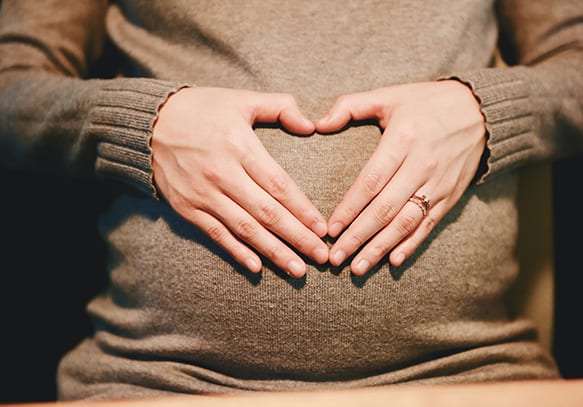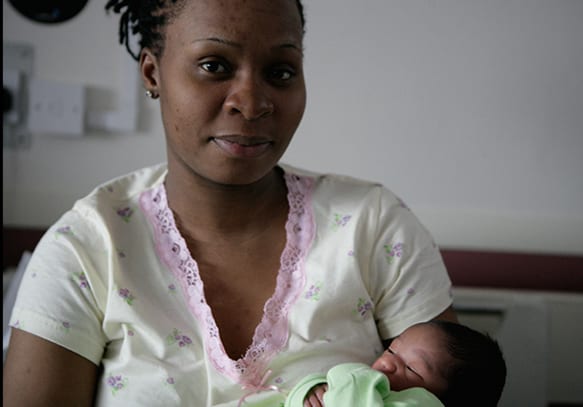Labour and birth (old)
There are 3 different stages in labour:
The First stage starts with the onset of regular contractions along with the dilation or opening of the cervix and ends when the cervix is fully open, said to be 10cm.
The Second stage, often known as the ‘pushing’ stage, starts from when the cervix is at 10cm and ends when the baby is born.
The Third stage is from the birth of the baby to when the placenta is delivered.
The topics below will provide you with information about the different aspects of labour and link to some further resources that you can explore.
Remember, if you have any concerns, for example if you are unsure whether you are in labour, your baby’s movements have changed or you think your waters have broken, you can always speak to a midwife, using the contact numbers on your green notes.
What to expect in labour.
Signs and symptoms of labour.
This video and the information graphic below will give you an overview of what signs to look out for.
Early Labour
Staying at home for as long as possible can help you through the early stage of labour. There are also many other ways you can help yourself:
it is a good idea to try and stay mobile and upright. Upright positions such as standing (or leaning onto a steady surface), sitting on a birthing (exercise) ball are good options. This is because gravity helps your baby’s head to move down into the pelvis and helps labour to progress. If you are in a birth centre in the early stages, there may be a birthing stool that you can use to sit and is designed to keep you in the right position. Choosing to be mobile and adopting these positions if you find them comfortable has been found to make labour shorter and reduce the chance of needing a caesarean section.
Movement, such as rocking your hips (you can also do this on all fours), pacing, or moving between positions can be helpful in coping with pain. As you find more comfortable positions, it helps you to feel in control of your labour and helps to avoid feelings that you need an epidural or other stronger pain relief.
Labour consumes a lot of energy and you need to keep yourself well and look after your body. It is a good idea to drink water to keep your energy levels up and this is important throughout pregnancy as well as labour. If you do get dehydrated, you may become exhausted and your labour may stop progressing.
Energy levels may also be improved by eating, although your appetite tends to reduce when in labour, so small snacks may be preferable. Try eating small light meals containing carbohydrates, such as banana, toast, fruit, pasta or cereals. You may be advised not to eat during labour in some circumstances, so isotonic drinks (such as lucozade sport/powerade or any other electrolyte non-fizzy drink) can help to keep your energy levels up.
Resting during early labour and between contractions can help to prevent you from getting exhausted when in labour. Try playing relaxing music and dim the lights to aid relaxation and sleep.
Remember to keep going to the toilet at regular intervals, as a full bladder may prevent baby from moving down into the pelvis.
Staying calm and relaxed will help the hormone Oxytocin (responsible for labour progress) to flow. Keep your breathing slow, deep and steady through each contraction. Gently blowing by pursing your lips as you breathe out can help.
Take mild painkillers. Paracetamol can be taken at home you can take 1g (which is usually 2 tablets) 4-6 hourly and no more than 4g or 8 tablets in 24hours.
During this stage it is important to choose a supportive birthing partner who can be with you throughout your labour. Choosing the right birthing partner will have an impact on your birth experience and it is good to have someone you can trust and feel comfortable with. Your birthing partner can encourage and reassure you throughout your birthing journey. It will also be an unforgettable memory you both hold dear to your hearts.
Birth Partner Information/Role of Birth Partner
Environment for birth
Personal Protective Equipment (midwives will use)
Hypnobirth
Some women find hypnobirthing an effective pain management technique and have had a very positive experience using it. Antenatal classes are usually available to teach self-hypnosis, supplemented with audio recordings that you can listen to during your pregnancy and labour. However, through this current period, there are many online courses available to support you with this and Youtube can be a very useful tool as well.
Hypnotherapy works by changing how you perceive pain, and by using this technique in labour you can enter a mental state where painful sensations can become easier to cope with and less unpleasant. It combines breathing techniques with relaxation, visualisation and mindfulness, to help you focus on yourself and your baby during your labour and delivery. You will learn and practise deep relaxation techniques over and over again during pregnancy in advance of your labour. By the time labour and contractions start, you will have taught yourself to relax, rather than to be frightened or anxious. The more relaxed you are, the easier it is to cope with labour.
This form of pain relief might be useful for you to use as a coping mechanism through early labour, or might assist you throughout the whole of your labour. This is a personal experience and is completely dependent on each person using it.
Labour can also be a very daunting time for birth partners and can lead them feeling left on the side lines and feeling as though they can’t help. However, using hypnobirth techniques can be done in partnership, making the birthing experience a more intimate and positive experience for you both.
Please discuss hypnobirthing with your midwife or look for online classes and once permissible classes taking place in your local area. You might also wish to add it to your birth plan, so that when you arrive at the hospital to have your baby everyone is aware of your preferences for labour.
Coping with pain
There are some things that you can do at home to cope with the pain during the Latent phase of labour at home and one way to cope is by taking warm baths or showers. In the bath, making sure that if possible, your bump is under the water, as this will help the warm water to interfere with the nerve signals that carry the pain to your brain, this will relieve the pain and make you feel relaxed and calm. If you have a shower with an attachment, letting the warm water flow over the area that feels sore can also help. When you are in pain, your muscles tend to tense up naturally and warm water will help to relax the aching tense muscles and make the contractions easier to manage.
Breathing techniques are also a good way to cope with pain at home in the latent phase of labour. When you focus on your breathing, it will help you go through each contraction taking your mind off the pain. It also helps you feel more in control and cope better with the pain. In the latent phase the main thing is to try and breathe slowly and rhythmically; the rhythmic breathing will help to conserve your energy and ease the pain. As soon as you can feel a contraction starting, breathe in slowly through your nose, drawing the air deeply into your lungs, pause for a moment and then breathe out slowly through your mouth. As you are breathing out, try to relax your muscles and let go of any tension and when your contraction is over make sure that you relax and rest as much as possible before the next contraction.
Pain relief options
TENS machine:
A TENS machine can help you with contractions in the latent phase of labour. TENS stands for Transcutaneous Electrical Nerve Stimulation. The machine can be bought at several major outlets or can be hired – please see our further information on this topic for some suggested places to obtain one.
The TENS machine works in a similar way to acupuncture, as it helps by interfering with the painful nerve signals caused by the contractions. The TENS impulses block or reduce the pain signals travelling to the spinal cord and brain which helps to lessen the pain.
TENS is operated with a battery and you attach four sticky pads holding the electrodes to the skin on your lower and mid-back.
When you turn the TENS machine on, you will feel small electrical impulses which may feel like a tingling sensation. You are completely in control of the settings, which can be altered based on the strength of your contraction, there is a ‘boost’ button and you can click it as soon as your contraction starts. TENS also relieves pain by stimulating the body’s natural pain killer known as endorphins and will not affect or harm your baby. The TENS machine cannot be used in water as it is an electrical device. Here is a picture showing how to position the sticky pads on your back.
Non-pharmacological pain relief:
This type of pain relief involves any method of pain relief that is non-invasive and does not involve medications to treat pain. Non-pharmacological techniques include:
- Water birth
- Water immersion
- Transcutaneous electrical nerve stimulation (TENS)
- Aromatherapy
- Acupuncture and acupressure
- Massage techniques
- Relaxation techniques such as hypnobirthing
- Birthing balls and positions
While it is true that there is a lack of evidence as to how effective the majority of these different approaches can be, many women use them when in labour and find them useful. Ultimately, it is your choice as to which option you feel will best support you with your own birthing experience, so do as much research as you can and ask your midwife about them.
You can find out more on the NHS website.
Role of Oxytocin
During labour, contractions slowly push the baby further down the pelvis and the pressure of baby’s head against the cervix encourages your body to release Oxytocin hormone. Oxytocin is a hormone produced by the brain as well as the placenta and membranes surrounding your baby and it helps your labour to progress. Its production is inhibited by stress, which is why it is important to remain as calm as possible throughout labour, taking time to remember that you are in control.
First stage of Labour
The First stage can be broken down into the Latent phase and the Active phase. The Latent phase is the early part of your labour and can consist of irregular contractions that can be uncomfortable or painful. This will not be constant – it can come and go in a cluster of contractions that might then settle for a long period of time and you will be able to rest and recoup in between. It can feel like you are experiencing period-type pain or backache to start with, and throughout this time the cervix (neck of the womb), is becoming softer and thinner. This can take a few days, particularly for first time mothers, until the contractions slowly start to build up, becoming more regular and more painful as the cervix begins to stretch and open up to 4cm. For women who have had a baby before, this phase can be much quicker, lasting around 6 hours or even shorter.
The Latent phase is followed by the Active phase of the first stage of labour, which is more intense and is normally shorter than the latent phase. You will hear staff refer to ‘established labour’ and this is what they mean. The Active first stage of labour is when the cervix opens from 4cms to 10cms to allow for the baby to pass through.
If this is your first baby, the active first stage of labour will last on average 8-10 hours (maximum usually less than 18 hours) and will be shorter if you’ve given birth before, at around 5 hours (maximum usually less than 12 hours).
During this active phase of labour, contractions become more powerful, stronger, more regular and longer-lasting. They normally last about 60 seconds each, with at least 2 contractions in a ten-minute period, and there should be time to rest between contractions.
The muscles of the womb contract, but they do not relax completely after each contraction, resulting in the cervix being pulled upwards which makes it dilate. At the same time, the contractions slowly push the baby further down the pelvis and the pressure of baby’s head against the cervix encourages your body to release more Oxytocin hormone to keep your labour progressing.
The waters around baby often break during established labour, but they may have already broken and sometimes do not break at all until the baby is born.
Once you are in the Active first stage of labour, the midwife will want to check you and your baby, in order to make sure that you are both okay. She will offer to take your observations, such as your temperature and blood pressure etc; this will indicate whether everything is as expected. She will ask about your baby’s movements and will listen to baby’s heartrate, using a hand-held machine called a doppler or the larger fetal heart monitor (CTG machine) that is used on the Consultant obstetric Labour ward. For further details about the different types of monitoring, please see our topic ‘Fetal Heart Monitoring in Labour’.
The midwife will also offer to monitor your progress in labour by analysing the contractions to see how strong, long and regular they are. Progress in labour can also be monitored by vaginal (internal) examination. The vaginal examinations consist of an initial assessment and then repeated every four hours during active labour to see how soft, thin and open your cervix is. All monitoring will be offered to you with an explanation of why it is being offered and it is your choice whether to accept. It is important to remember to ask questions if you are unsure of anything. You can ask about the benefits and risks of any interventions offered to you, and you can ask about possible alternatives or what happens if the internal examinations are not done.
Once your cervix is fully dilated (10cms open) there can be a period of transition or change, where contractions may ease off a little as baby begins its descent into the pelvis and gets into the correct position. At this stage you may begin to feel overwhelmed and agitated, but this tends to only last around 15 minutes or so and your midwife will support you through this – it can be a good sign that your baby is almost here! As the contractions continue, you may begin to experience an urge to push and usually that is when the second stage of labour is commenced. Occasionally, some women will experience the urge to push before the cervix is fully dilated and the midwife may ask you to change positions and other approaches to reduce the urge to push.
Latent phase of labour
The Latent phase is the early part of your labour and can consist of irregular contractions that can come and go. The contractions can settle down for long periods of time and you will be able to rest in between.
It might feel like you are experiencing period-like pain or backache to begin with, and usually means that changes are starting to happen to your body. The cervix, or womb, is like a long tube (2-3cm long), and during these early stages of labour, it begins to shorten and go from being thick to paper thin – this is known as ‘effacement’. The latent phase refers to the period of effacement and dilatation from 0-4cm (you are fully dilated when you get to 10cm).
The Latent phase can take a few days, particularly for first time mothers, as the contractions slowly start to build up, becoming more regular and more painful as the cervix begins to stretch and open up to 4cm. For women who have had a baby before, this phase can be much quicker, lasting around 6 hours or even shorter.
You will hear the phrase ‘tightenings’, which refers to the mild contractions of the muscle in your uterus that you begin to experience as you start in labour. They are infrequent to begin with, occurring around every 20 minutes and lasting around 20 seconds during the latent phase. You will feel these contractions begin at the top of your uterus (womb) and spread out, almost like a wave across your uterus, slowly becoming stronger. These muscles contract, but they do not relax completely after each contraction, resulting in the cervix being gently pulled upwards, which makes it dilate. At the same time, the contractions slowly push the baby further down the pelvis and the pressure of baby’s head against the cervix encourages your body to release more Oxytocin hormone.
Active birth: positions for birth
In early labour, you may feel restless and want to move around and keep busy as a way of distracting yourself from your contractions.
However, during this time you should try your best to get as much rest as possible before the contractions become stronger and more frequent. You will need plenty of energy later on.
Once your contractions become more regular, you may wish to stay mobile and upright. This may help you to cope with the contractions, and it is also really beneficial in helping your baby to move further down the birth canal in preparation for birth, thus helping to progress labour.
Sitting upright on a birthing (exercise) ball does help your baby to move down further down the pelvis, as well as easing back pain and increasing the blood flow to your pelvic area.
Any upright birthing positions are recommended for the same reasons. It is important that you move into any position you find comfortable and this may change throughout labour.
You may wish to lean against a wall or the back of a chair, kneel on a cushion, sit on a chair or birth ball, go on all fours, or lean on your partner. You may wish to try these with your partner at home if it helps you to experience it, ready for when your day arrives.
You may also wish to go and look at some pictures online that demonstrate the many different positions which may help you in labour. This poster gives you an idea of some birth positions.
Many hospital trust websites now provide information regarding pain relief options as well as having visual aids of popular birthing positions, so please, so ask your midwife about this.








